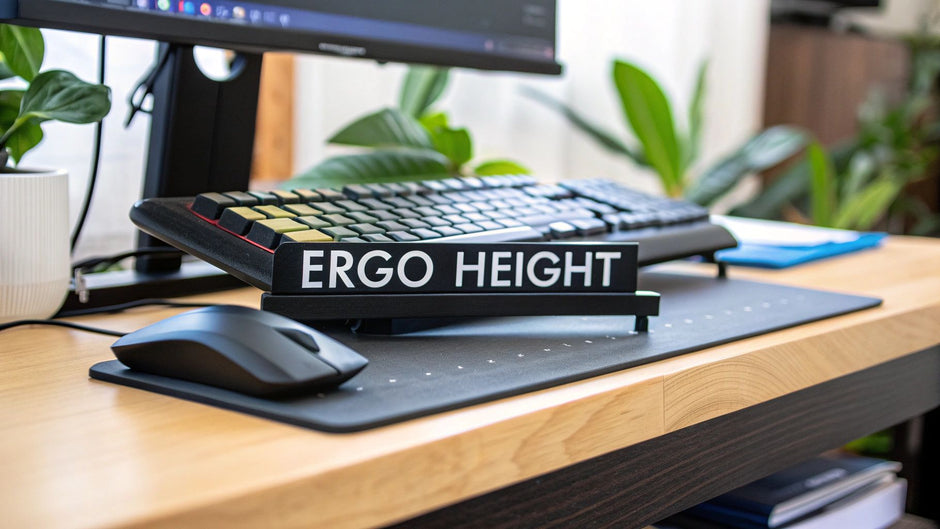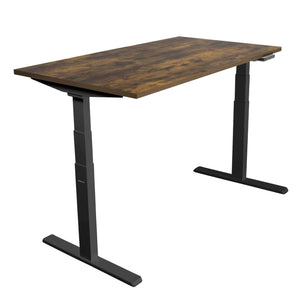An ergonomic desk height calculator is a fantastic tool, but it's only as good as the posture you bring to it. The quickest rule of thumb? Your elbows should naturally form a 90-degree angle when you’re typing, and your feet should rest flat on the floor. This applies whether you're sitting or standing.
Why a Quick Posture Check Matters
Before you even think about plugging numbers into a calculator, take a moment to do a quick posture check. This simple first step can immediately highlight any major problems with your current setup. It helps you understand the why behind the measurements, which makes the final adjustments feel much more intuitive. The goal isn't just to hit a specific number; it's to create a workspace that supports your body's natural alignment.
This focus on well-being isn't just a trend; it's a significant shift in how we approach work. The global market for adjustable height desks is expected to hit $15 billion in 2025 and is projected to grow at a 7% compound annual growth rate through 2033. This boom is fueled by a growing awareness of ergonomics as more people look to avoid the aches and pains that come from a desk-bound job.
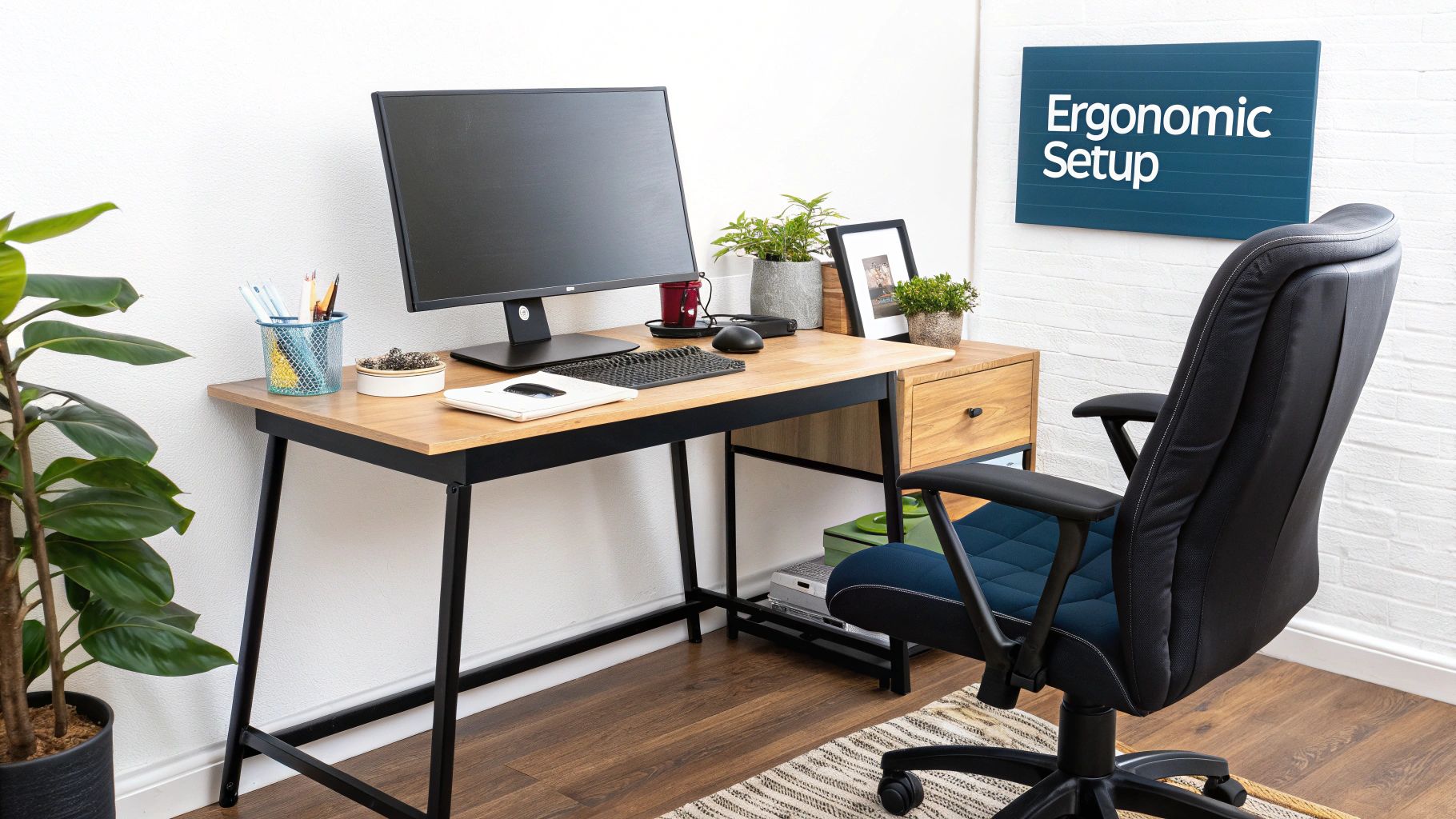
Key Body Alignment For Sitting vs Standing
A one-size-fits-all desk height is a recipe for discomfort because everyone's body is different. What works for a coworker could easily give you neck strain or wrist pain. The real key is to tailor the desk height to your body, both when you're sitting and standing. Getting familiar with the basics of optimal desk ergonomics is the first, most crucial step toward a healthier workday.
The ideal setup supports a neutral posture, where your joints are naturally aligned and your muscles aren't working overtime. This simple principle is the foundation for preventing long-term strain.
To help you get started, here's a quick comparison of the ideal body alignment for both sitting and standing. Think of this as your pre-flight checklist before you start fine-tuning.
Quick Ergonomic Posture Table
This table breaks down the key body alignment points for sitting versus standing at a glance. Use it to spot major posture issues before you start measuring.
| Body Part | Ideal Sitting Position | Ideal Standing Position |
|---|---|---|
| Feet | Flat on the floor or resting on a footrest. | Flat on the floor, about shoulder-width apart. |
| Knees | Bent at roughly a 90° angle. | Comfortably straight but not locked. |
| Elbows | Bent at a 90° angle and held close to your body. | Bent at a 90° angle and held close to your body. |
| Wrists | Kept straight and in line with your forearms. | Kept straight and in line with your forearms. |
| Eyes | Level with the top third of your computer monitor. | Level with the top third of your computer monitor. |
Spotting these simple alignment cues will help you recognize what proper posture actually looks and feels like, making the entire process of setting up your ergonomic desk that much easier.
Calculate Your Ergonomic Desk Height
Figuring out your ideal desk height isn't just a guessing game. It's a science, but a simple one. The idea is to match your workspace to your body's measurements, creating a setup that feels natural and supportive, not one that forces you into awkward positions. Let's turn those abstract ergonomic ideas into a concrete, personalized height that works for you.
The whole process really boils down to one key measurement: your elbow height. Whether you're sitting or standing, you want your forearms to be parallel to the floor, with your elbows bent at a comfortable 90-degree angle. This is your neutral posture—the sweet spot that prevents shoulder shrugging and forward hunching. It’s the foundation for everything else.
Essential Inputs for Your Calculation
Before you jump into a calculator, you need to gather a few details. Getting these right from the start will give you a much more accurate and comfortable result. Think of it as providing the right ingredients for the perfect recipe.
- Your True Height: Make sure to measure yourself while wearing the shoes you normally wear at your desk. It sounds minor, but a half-inch from a thick-soled shoe can easily throw off your standing desk height.
- Keyboard and Mouse Setup: Do you use a chunky mechanical keyboard or a super-slim one? The thickness of your keyboard directly affects your wrist angle, so it’s an important piece of the puzzle.
- Accessories: Don't forget to account for things like an under-desk keyboard tray or an anti-fatigue mat. These items will change the relative height between you and your work surface.
Understanding how to incorporate ergonomic design into your workspace is about more than just the desk; it's about tying all these elements together into a setup that promotes good health.
Using an Ergonomic Desk Height Calculator
Thankfully, digital tools make finding your starting point a breeze. Most online calculators just need your height and whether you plan to sit or stand to give you a solid recommendation.
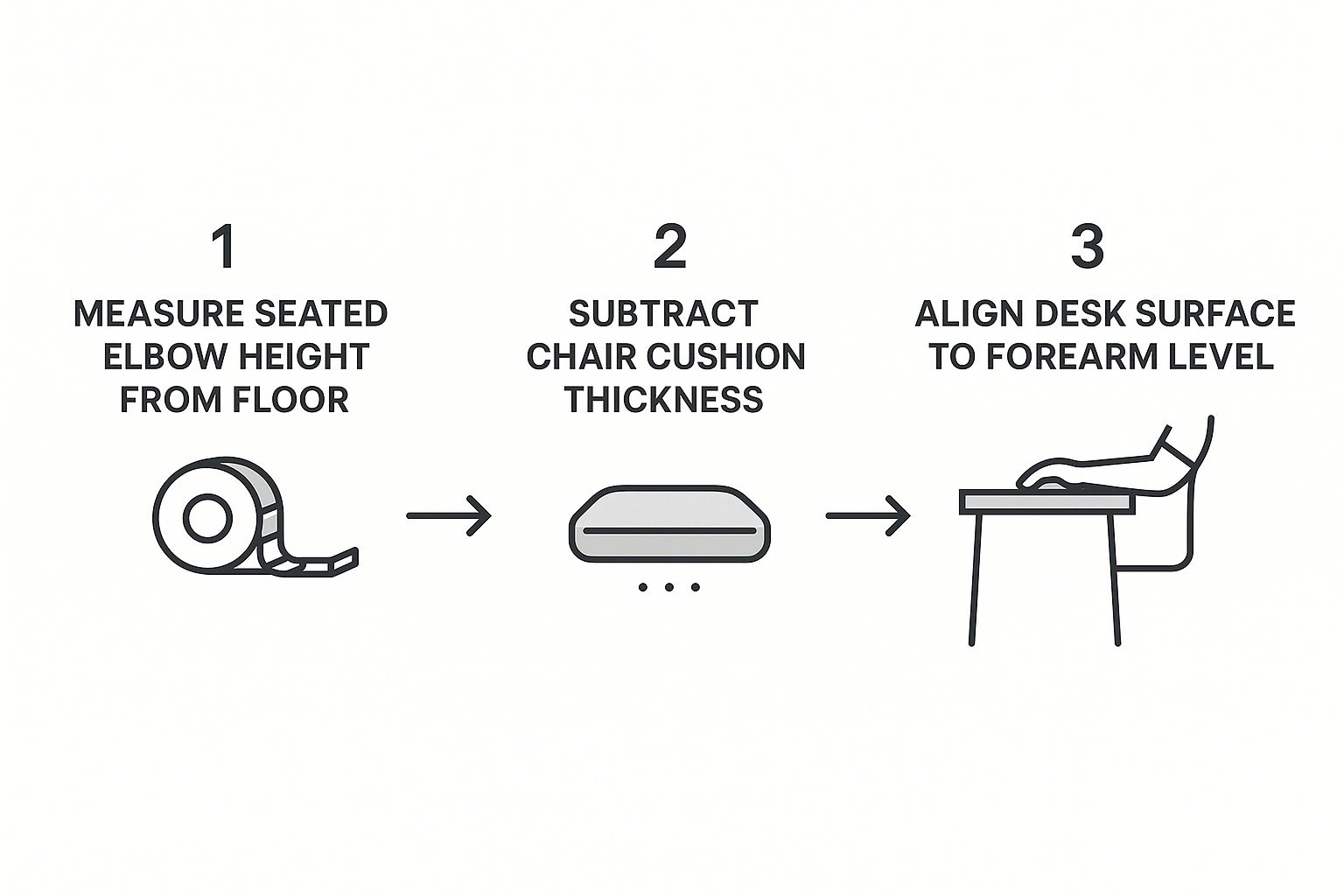
As you can see, a good workspace planner uses your measurements to suggest ideal heights for your desk, monitor, and chair. It helps you visualize what that perfectly aligned posture actually looks like.
Pro-Tip: Treat the calculator's number as your starting point, not the final answer. Use it to get in the right ballpark, then fine-tune it by making small adjustments up or down until it feels just right for your body.
The demand for this kind of personalized setup has skyrocketed. In fact, the market for height-adjustable desks is projected to hit $7.58 billion in 2025. This growth is all thanks to the well-documented health benefits of ergonomic workspaces, which are becoming a must-have for anyone spending long hours at a desk.
Set Up Your Ergonomic Workstation
So, you've used a calculator or measured your way to the perfect desk height. That's a great start, but it's just one piece of the puzzle. The real magic—and the real comfort—happens when your entire workstation works in harmony. Think of it like tuning a guitar. Getting one string right is a good first step, but you need all of them playing together to create actual music.
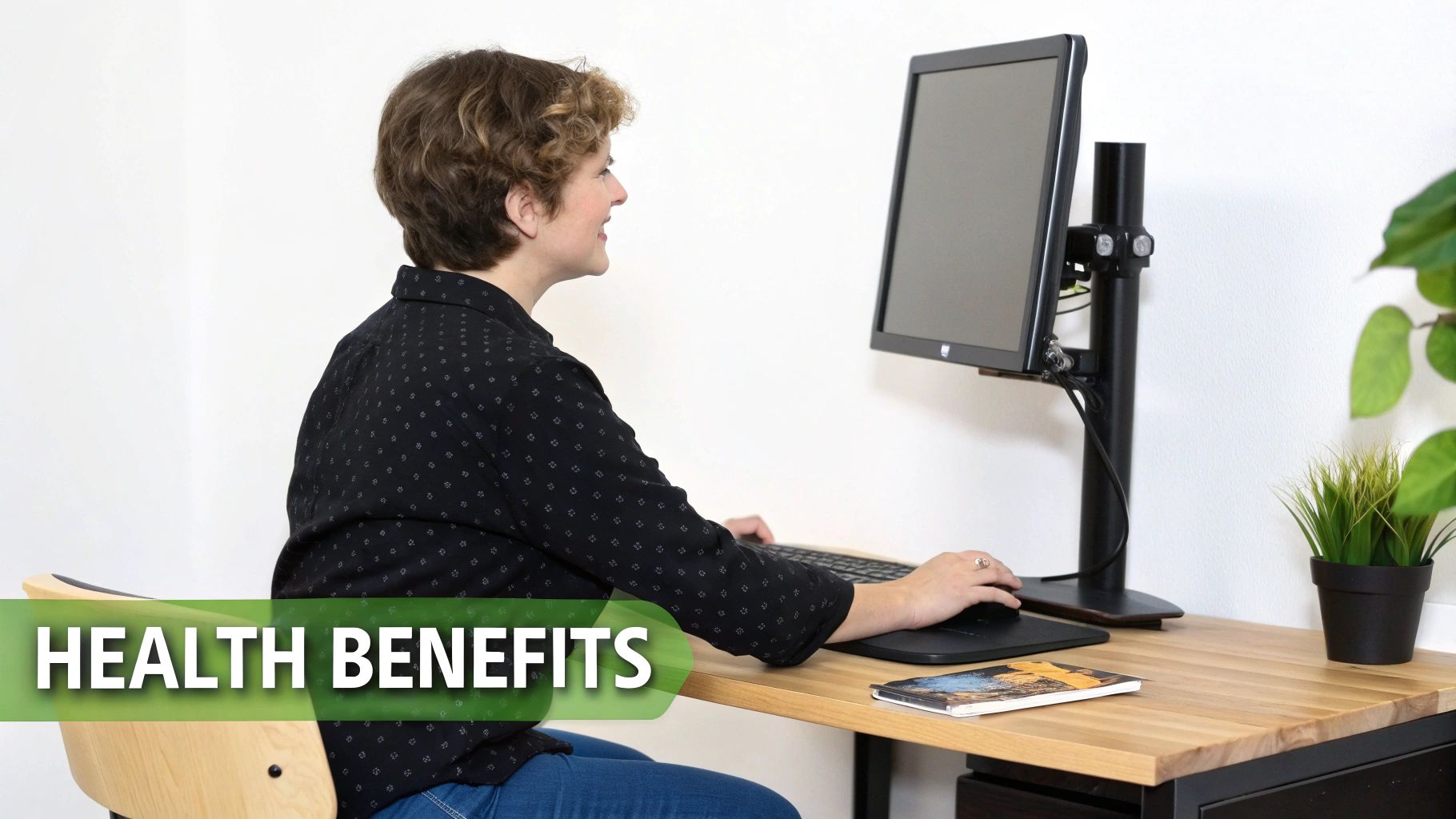
This holistic approach is exactly why ergonomic furniture isn't just a niche product anymore. The market for height-adjustable desks was valued at around USD 2.07 billion back in 2016. Fast forward, and it's projected to hit USD 3.06 billion by 2028. This isn't just a trend; it's a worldwide recognition that a healthy workspace is a productive one.
The Monitor Is Your Focal Point
More than any other piece of gear, your monitor dictates the posture of your head and neck. If you want to avoid that dreaded "tech neck," getting this right is non-negotiable.
The goal is to position your monitor so the very top edge of the screen is at, or just a hair below, your eye level. This way, you’re looking straight ahead or slightly down, but never craning your neck upward. A simple trick to check the distance? Sit back, extend your arm, and your fingertips should just about touch the screen.
A monitor that’s too low makes you crane your neck down. One that's too high forces you to tilt your head back. Both are a fast track to long-term strain and discomfort.
Have a dual-monitor setup? Place your main screen directly in front of you. The secondary one should be off to the side. If you use them both equally, nestle them together so their inner edges meet right in the middle, forming a gentle, ergonomic curve.
Dial In Your Chair and Peripherals
With your monitor in a good spot, let's bring your chair and other tools into the mix. Your chair is the foundation for your posture, giving you the stability you need to sit correctly.
Adjust your chair until your thighs are parallel with the floor and your feet are resting flat. If your feet are dangling, a simple footrest can make a world of difference. Make sure you feel that gentle support on your lower back from the chair's lumbar curve.
Now, pull your keyboard and mouse in close. Your elbows should hang comfortably at your sides, not jutting out. This simple adjustment keeps your wrists in a neutral, straight line—absolutely vital for preventing repetitive strain injuries. If wrist pain is already a concern, it's worth exploring some expert advice on 6 actionable ways to relieve wrist pain from typing.
Real-World Ergonomic Scenarios
Putting these principles into practice will look a little different for everyone. Here are a couple of common situations I see all the time:
- Laptop-Only Setup: This is a classic ergonomics problem. A laptop screen is almost always too low. The fix is to put your laptop on a stand or even a sturdy stack of books to get the screen up to eye level. Then, you absolutely must use an external keyboard and mouse to keep your arms and wrists in a healthy position.
- Fixed-Height Desk: If your desk is a fixed height, you have to adapt everything else around it. If it’s too high for you, raise your chair and use a footrest to support your feet. If it’s too low, you can use sturdy desk risers to lift the entire work surface.
Every single element, from your desk height down to the position of your mouse, works together. For an even more detailed walkthrough, check out our complete guide on creating a comprehensive ergonomic desk setup.
Fix Common Desk Setup Mistakes
So you've used a calculator to find your perfect ergonomic desk height. That’s a great start, but it's surprisingly easy to fall into other common setup traps. You get the desk height just right, but now your shoulders are aching, or your wrists feel strained. What gives?
The problem is that your workstation is a complete system. When you change one part—like your desk height—it throws everything else off balance. It's like trying to balance a scale; you can't just add weight to one side and expect it to level out. You need to make small, thoughtful adjustments to your chair, monitor, and peripherals to find that sweet spot of ergonomic harmony.
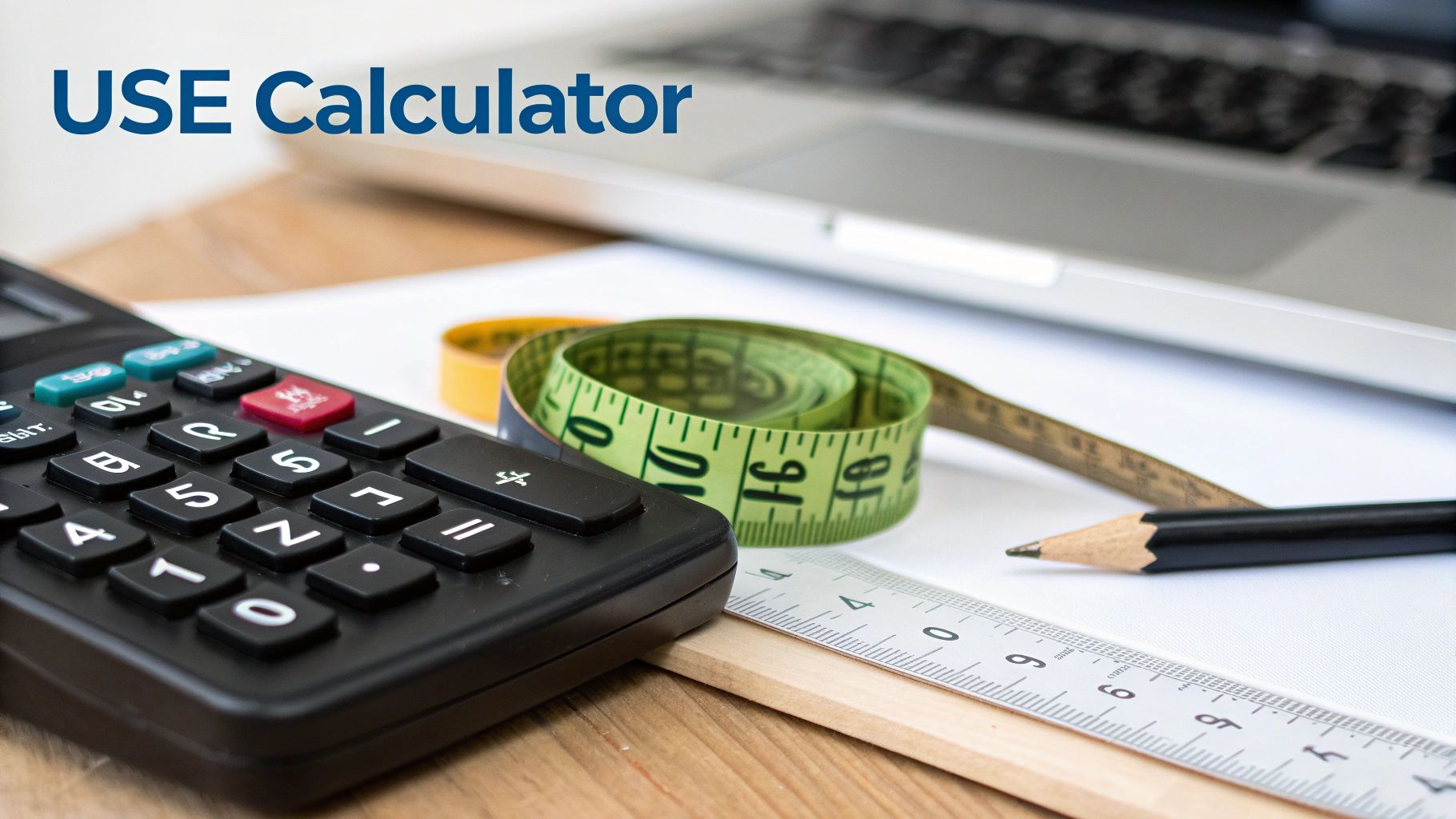
Let's walk through some of the most common issues I see and how to fix them.
The Tell-Tale Shoulder Shrug
One of the most frequent mistakes is setting a standing desk just a smidge too high. It might not feel wrong at first, but after an hour, you'll notice a creeping tension in your neck and shoulders. This is the "shoulder shrug"—an unconscious habit where you raise your shoulders to reach a keyboard that’s too high.
The fix is simple. Lower your desk in tiny increments until you feel your shoulders naturally drop into a relaxed, neutral position. Your elbows should hang comfortably at your sides, forming that ideal 90-degree angle without any effort on your part.
Hunching Over a Low Desk
The opposite problem is just as bad. If your desk or, more commonly, your monitor is too low, you’ll find yourself hunching forward to see the screen. This posture puts a ton of strain on your upper back and neck, which is a fast track to persistent aches and pains.
The solution here is a two-part adjustment:
- Bring your monitor closer. Your screen should be about an arm's length away. This simple change keeps you from leaning in to read text.
- Raise your monitor height. The top of your screen should sit at or just below your eye level. A dedicated monitor stand is best, but a sturdy stack of books works in a pinch.
An ergonomic setup isn't static. Think of it as a dynamic space that needs to feel comfortable and supportive throughout the day. If you feel any strain, tingling, or discomfort, that's your body telling you something is wrong. Listen to it and make adjustments.
Neglecting Your Wrists and Chair
Perfect desk height means very little if your wrists are bent at weird angles or your back has zero support. These "secondary" elements are just as critical for long-term comfort and preventing issues like carpal tunnel syndrome.
Wrist Alignment: Take a look at your hands on the keyboard. Your wrists should be straight, almost forming a straight line with your forearms. If they're bending up or down, your keyboard or chair position is probably the culprit. An adjustable-height chair with armrests or a low-profile keyboard can often solve this instantly.
Chair Support: A good ergonomic chair is designed to support the natural curve of your lower back. If you can slide your hand into the gap between your back and the chair, you're not getting proper lumbar support. This can lead to serious back pain over time. Adjust the backrest or add a dedicated lumbar pillow to fill that gap.
By spotting and correcting these common problems, you can turn a good setup into a great one. For a more detailed walkthrough, you can learn how to fix common desk setup mistakes in our complete guide.
Add Movement to Your Ergonomic Routine
Even with a perfectly dialed-in desk, you're not immune to the aches and pains that come from staying in one position for too long. A truly ergonomic setup is more than just hitting the right numbers on a desk height calculator—it’s about creating a dynamic routine that weaves in regular movement. After all, our bodies are built to move, not to be locked into a single pose for hours on end.
Think of your workday less like a marathon and more like a series of short sprints. Breaking up long stretches of either sitting or standing is the secret to keeping your energy up and your focus sharp. By adding a little motion here and there, you boost circulation, keep your muscles from getting stiff, and push back against that dreaded afternoon slump.
Build a Sit-Stand Habit
The easiest way to get more movement into your day is to establish a simple rhythm for switching between sitting and standing. You don't need a complicated schedule. In fact, a simple, repeatable pattern is far more likely to stick. The real goal is to make movement a natural, almost subconscious, part of your workflow, not another task on your to-do list.
I've seen these two methods work wonders for people in real office settings:
- The Pomodoro Approach: This classic productivity hack is fantastic for ergonomics. Work while seated for a focused 25-minute burst, then use your 5-minute break to stand, walk around, or do a quick stretch. It’s a game-changer.
- The 30:30 Rule: A perfectly balanced option is to simply alternate between 30 minutes of sitting and 30 minutes of standing. This consistent switch-up stops your body from settling too deeply into either posture.
The best routine is the one you can actually stick with. Don't be afraid to experiment with different timings to find what feels right for your body and your work, whether you're hopping on client calls or getting into a deep coding session.
Weave in Simple Desk Stretches
In those little moments between your sit-stand cycles, you can fight off stiffness even more with simple movements you can do right at your desk. These micro-breaks are surprisingly effective for releasing tension in hotspots like your neck, shoulders, and wrists. For a deeper dive into protecting your joints, our detailed guide explains how to avoid injuries from poor ergonomics.
Try peppering these easy stretches into your day:
- Chest Openers: Clasp your hands behind you and gently squeeze your shoulder blades together. It’s the perfect antidote to hunching over your keyboard.
- Neck Rolls: Slowly and gently tilt your head from side to side, then nod forward and back to ease neck strain.
- Wrist Flexes: Extend your arms out and gently flex your wrists up and down. This feels amazing after a lot of typing.
- Calf Raises: While standing, just rise up onto your toes and then lower back down. It’s a great way to get your blood moving.
Have a Question? We Have Answers.
Even with the best tools and guides, you're bound to have some specific questions pop up as you dial in your perfect setup. Let's tackle some of the most common ones we hear about using ergonomic calculators and fine-tuning your workspace for real, lasting comfort.
How Often Should I Switch Between Sitting and Standing?
There’s no single magic number here, but a great place to start is the 30:30 rule: aim for 30 minutes of sitting, then 30 minutes of standing.
Honestly, the most important thing is to listen to your body. If you feel that familiar stiffness, fatigue, or just a general restlessness creeping in, that's your cue. It’s time to change your position. A simple timer on your phone or computer can be a game-changer in the beginning, helping you build the habit until it feels like second nature.
Do I Need to Adjust My Desk Height for Different Shoes?
Yes, absolutely. It's one of those small details that makes a huge difference. A pair of running shoes with thick soles or even a slight heel can easily add an inch or more to your standing height. That’s more than enough to throw your entire ergonomic alignment out of whack.
Always take your measurements—and use the ergonomic desk height calculator—while wearing the shoes you actually work in. If you're someone who switches between flats and heels, it’s a brilliant idea to find the ideal height for each and save them as presets on your adjustable desk if it has that memory function.
Think of the calculator's result as a starting point, not gospel. Your body is the ultimate authority. Make small adjustments of about a quarter-inch up or down until you find the sweet spot where your shoulders are relaxed and your wrists are neutral.
My Desk Isn't Adjustable. Now What?
Don't worry, you haven't been sentenced to a life of bad posture. You can still create a surprisingly ergonomic setup with a fixed-height desk. The trick is using the right accessories to bridge the gaps.
- If the desk is too high: The first step is to raise your chair until your elbows hit that sweet 90-degree angle. Your feet will now likely be dangling, so grab a dedicated footrest to make sure they can rest flat. This keeps your knees properly aligned and supported.
- If the desk is too low: Simple but effective: use sturdy desk risers to elevate the entire work surface. For your screen, a monitor stand (or even a ream of paper or a few sturdy books) will do the trick to bring it up to eye level.
The Calculator's Result Feels...Wrong. What Should I Do?
Trust your gut. Or, in this case, trust your body's feedback over any formula. An ergonomic desk height calculator gives you an excellent, science-backed baseline, but it can't possibly account for your unique body mechanics, old injuries, or simple personal comfort preferences.
If the calculated height feels off, don't just grin and bear it. Make small, slow adjustments until you land on what feels right for you. The goal is always a posture that feels effortless to maintain—where your shoulders are relaxed, your wrists are straight, and there's no strain in your neck or back.
Ready to build a workspace that truly works for you? Mount-It offers a wide range of ergonomic solutions, from sit-stand desks to monitor arms and accessories, all designed to enhance your comfort and productivity. Explore our collection at https://www.mount-it.com and start creating your ideal setup today.

